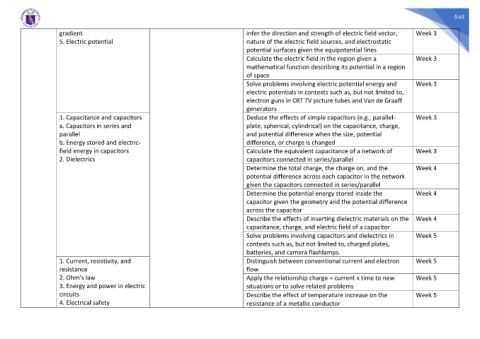Page 545 - Most-Essential-Learning-Competencies-Matrix-LATEST-EDITION-FROM-BCD
P. 545
545
gradient infer the direction and strength of electric field vector, Week 3
5. Electric potential nature of the electric field sources, and electrostatic
potential surfaces given the equipotential lines
Calculate the electric field in the region given a Week 3
mathematical function describing its potential in a region
of space
Solve problems involving electric potential energy and Week 3
electric potentials in contexts such as, but not limited to,
electron guns in CRT TV picture tubes and Van de Graaff
generators
1. Capacitance and capacitors Deduce the effects of simple capacitors (e.g., parallel- Week 3
a. Capacitors in series and plate, spherical, cylindrical) on the capacitance, charge,
parallel and potential difference when the size, potential
b. Energy stored and electric- difference, or charge is changed
field energy in capacitors Calculate the equivalent capacitance of a network of Week 3
2. Dielectrics capacitors connected in series/parallel
Determine the total charge, the charge on, and the Week 4
potential difference across each capacitor in the network
given the capacitors connected in series/parallel
Determine the potential energy stored inside the Week 4
capacitor given the geometry and the potential difference
across the capacitor
Describe the effects of inserting dielectric materials on the Week 4
capacitance, charge, and electric field of a capacitor
Solve problems involving capacitors and dielectrics in Week 5
contexts such as, but not limited to, charged plates,
batteries, and camera flashlamps.
1. Current, resistivity, and Distinguish between conventional current and electron Week 5
resistance flow
2. Ohm’s law Apply the relationship charge = current x time to new Week 5
3. Energy and power in electric situations or to solve related problems
circuits Describe the effect of temperature increase on the Week 5
4. Electrical safety resistance of a metallic conductor

